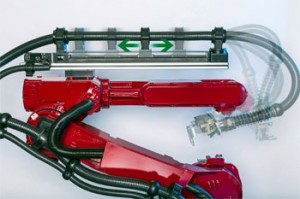Cable protection system for robotics applications
 A new cable protection system for robotics applications automatically moves the cable in sync with each operation of the robot arm, eliminating the potentially high mechanical loads which act on the dress pack in conventional spring-loaded length compensation systems, and so enabling the user to save on maintenance and, in many cases, to avoid high follow-up costs.
A new cable protection system for robotics applications automatically moves the cable in sync with each operation of the robot arm, eliminating the potentially high mechanical loads which act on the dress pack in conventional spring-loaded length compensation systems, and so enabling the user to save on maintenance and, in many cases, to avoid high follow-up costs.
The ERIKA active length compensation system unveiled by REIKU moves the dress pack along a linear guide track in synchronism with the robot’s functions, thus balancing out the difference between the maximum cable length and the actual length required at any given time. REIKU says this method results in substantially reduced material wear when compared with conventional trailing-type systems in which the excess cable is retracted via spring forces which act directly on the dress pack and increase with the amount of spring travel.
Accordingly, ERIKA reduces the risk of damage to the dress pack and its content, including cables as well as pneumatic and fluid-carrying hoses. The service life of these systems can thus be extended significantly, and costly down times can be minimized.
ERIKA is available as an accessory for new robot systems or as an add-on retrofit module for corrugated tubing in the 29 to 70mm nominal width range. Depending on the application, it may be configured for between 0.5m and 1m of operating travel, attaining traversing speeds of up to 2m/s. The controller keeping ERIKA in sync with the robot is a straightforward unit relying on defined trigger signals which are transmitted by the robot’s control system as it executes its sequential program. As a result, ERIKA can be integrated into existing installations without requiring any extensive programming.
The ERIKA system consists of five basic elements. The linear guide track with its electric motor and spindle drive is screwed firmly to the robot arm near the axis four. The carriage moving parallel to the robot arm, carrying the REIKU gripping clamp and combination jaw, serves to hold the corrugated tube and to move it axially. The combination jaw allows two corrugated tubes of different type or profile to be joined together. At both ends of the linear unit, a REIKU gripping clamp with sliding jaws guides the corrugated tube. The clamp pointing in the direction of axis six is attached to a rotary flange which provides additional stress relief to the tubing under major deflection angles. The opposite clamp, on the loop side, can be optionally fitted with a REIKU spring to prevent kinking of the corrugated tube. For optimum all-round protection against aggressive ambient factors, REIKU also supplies optional bellows to enclose the linear unit.
Klaus-Peter Scholten, Project Manager at REIKU, comments: “Through our customers, we are very familiar with the issues relating to the indispensable length compensation for dress packs on industrial robots. These packs may be agile enough when it comes to, say, rotating through up to 400 degrees about axis six while bending in axis five at the same time, but as they are often moved against the force of a return spring, fatigue fractures and breakage in the attachment areas are common. These phenomena often result in cable damage which may paralyze entire production sectors.”
Scholten continues: “With ERIKA we have now developed a cost-efficient solution which helps to avoid such failures intelligently. ERIKA knows the current cable length requirement at any given time. Accordingly, the system provides just the amount of cable needed for the current movement of the robot tool. As less cable is demanded, it retracts the excess cable without having to act against the reactive spring forces formerly relied upon. In addition, ERIKA protects the loop from getting snagged on the workpiece or on the robot itself; it also prevents uncontrolled vibrations that might impair the robot’s motion accuracy, and it makes sure the corrugated tube cannot get into hazard areas where it might be at risk from high temperatures or running machinery. The extra cost of an ERIKA system will usually be recovered with the first production breakdown that is successfully avoided.”
Visit the REIKU website for more information.
See all stories for REIKU















